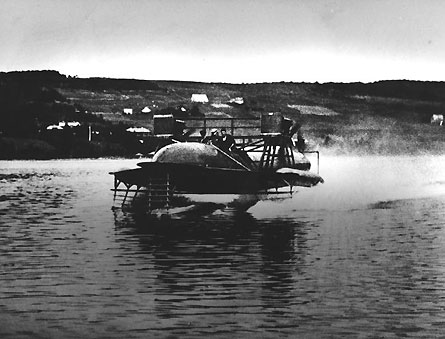Other American boats with naval possibilities may be discussed here. The first of these is the Hydrodrome, developed before and during the last war by Dr. Alexander Graham Bell and the Canadian engineer F. W. Baldwin.
The Hydrodrome (HD) relies on the fact that if a foil, somewhat similar in section to a plane’s wing but smaller in proportion to water’s density, is totally immersed in water and moved through it, it will bear weight just as an airfoil does. The HD has a boat-like hull, from which project three ladders, two on either side at the bow well out from the center line, and one at the stern integral with the rudder (which turns to steer the craft). The rungs of these ladders consist of cambered hydrofoils, the bottom ones being small and the upper ones larger. There may be 6 or so of the knife-like foils per ladder, and the two forward ladders are set at a considerable dihedral angle.
When the HD starts, she is first waterborne on the hull, then, as speed increases, the foils support her. Just as in an airplane, the faster she goes the less foil area will be required and the more upward force will be exerted. Therefore, at full speed, the HD climbs up the ladders, and is supported entirely by the bottom rungs, the other foils and the hull being lifted clear of the water. Thus there is absolutely no water resistance produced by the hull at slanting aspects.
Much work has been done (before and since the HD) on foil boats—usually foils skimming the water’s surface—but the HD remains unique in making use of the water reaction on top of an immersed cambered foil and in having sets of foils, so that balance would not depend on having one foil in the right position. HD designs even provide for “preventer” foils to catch a boat that might nose dive.
In 1917-18 Bell and Baldwin built their remarkable HD4 in Nova Scotia (the idea had earlier been offered to the American and British navies), which with two low compression Liberties attained a speed of 70.86 m.p.h. At this speed she was supported on only 4 square feet of foil surface. This boat was tested extensively in 1920 by a U. S. Navy commission under Rear Admiral Strother Smith, and also by a British Admiralty commission, and there is no doubt that she was an amazing machine. She ran successfully in waves 2½-3 feet high, without difficulty carried two 1,500- lb. loads on each side 5 feet from the center line, and did not even list when only one 1,500-lb. load was aboard (as would be the case if one of the two torpedoes had been fired). It is further plain that the small foils, so far from being fragile, are very robust, as has been proved when HD’s hit floating objects. In their report, U. S. Navy Commission said:
It is the opinion of the Board that at high speed in rough water the boat is superior to any type of high speed motor boat or sea sled known. The general impression obtained by riding in this boat is one of stability, seaworthiness, and ability.
The HD principle has also been proposed for naval targets, which could thus be towed at very high speeds.
Outside of extracts from the U. S. Navy report and statements of those assorted with its development, little has been published about the Hydrodrome; and it is difficult to come to a conclusion from this evidence alone. The HD appears to be much the most efficient type of high speed boat known, yet none of the more recent experiments have been entirely successful, and the Navy Department, in spite of favorable comments in the 1920 report, is now building boats of more conventional type. One obvious objection to the HD – it may or may not be conclusive – is that in big seas the foils might get into such positions that they would tend to drag the HD under instead of supporting her. One can only say that the case for the HD is not yet proved.



